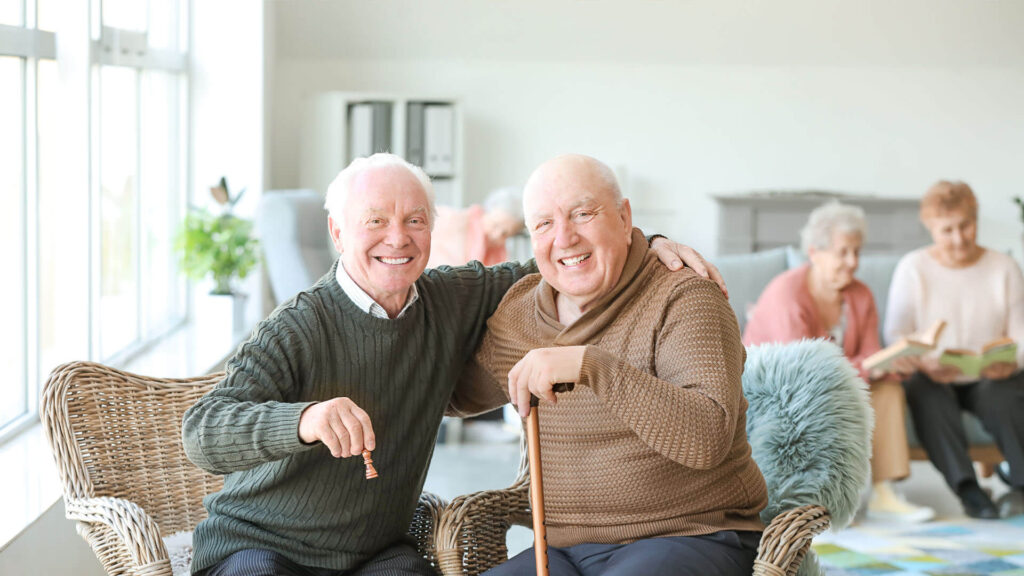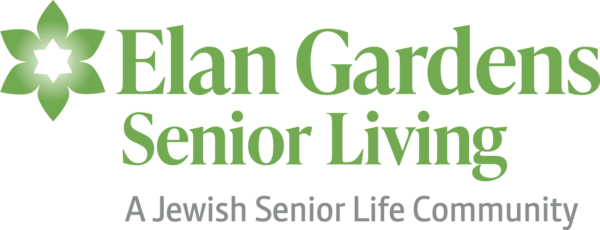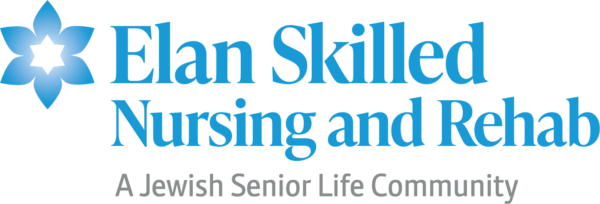Elan Skilled Nursing and Rehab, A Jewish Senior Life Community, provides a variety of activities to promote senior activity. There are numerous studies that support the benefits of activity not only for physical and mental wellbeing but an overall improvement of one’s quality of life.
Quite simply activity is important. Your physical health is a key aspect to maintaining independence – strong muscles, solid balance, and stamina will help you bring groceries into the house, play with your grandchildren, and allow you to be more resilient should you fall or have an illness.
Physical activity has immediate health benefits including better sleep and less anxiety. It can also help you feel better, improve your balance, and boost your brain health. It also reduces your risk of chronic conditions such as heart disease, Type 2 diabetes, and depression.
Beyond the physical and mental health benefits of exercise, if you exercise outside your home it’s a good opportunity to meet friends, provide social stimulation, and avoid isolation.
Any exercise is better than no exercise
According to the Centers for Disease Control, adults aged 65 and older need at least 150 minutes a week of moderate-intensity activity such as brisk walking, or 75 minutes a week of vigorous-intensity activity such as hiking, jogging, or running. Additionally, it is recommended that seniors practice activities that strengthen muscles at least two days a week, and activities to improve balance—such as standing on one foot—about three days a week.
150 minutes might seem like an unreachable goal but re-framing the weekly recommended guideline into a daily activity goal will make it more manageable and position you for success! A 15-minute walk both in the morning and afternoon along with a tai chi or yoga session a few days a week can help you achieve the recommended activity guideline and boost your health. Small amounts of physical activity accumulated throughout the day adds up to provide you with the health benefits associated with increased activity.
Moderate vs. vigorous aerobic activity
Everyone’s fitness level is different. Your age, gender, current physical condition, diet, sleep habits, environment and even heredity all play an important role in physical fitness. Rather than focus on what “should” count as moderate or vigorous exercise, simply evaluate how different activities make you feel. Your perceived exertion level may be different than your friend or your neighbor’s when doing the same exercise. Understanding that this is perfectly normal and exercising to your comfort level without overexerting yourself is what is important. Exercise will likely increase your heart rate and respirations (rate of breathing)—typically, the more intense the activity the higher your heart rate and breathing rate.
A rough gauge of intensity would be to evaluate your rate of breathing. Moderate-intensity activity increases your breathing to the point where you can still have a conversation, but can’t sing. Whereas, with vigorous activity you are breathing hard and are unable to say more than a few words without stopping to catch your breath.
Your key to success is to avoid pushing yourself too hard. If you are short of breath, in pain or can’t continue the activity as long as you planned you are probably exercising harder or higher than your current fitness level can accommodate. The best approach is to ease up and slowly build up your intensity. Overexertion often leads to injuries, which can sabotage your health goals.
What are good exercises for seniors?
Whether you go to a gym or work out at home, choosing activities that you enjoy is your key to success. You will be more apt to continue your exercise plan when the activity is enjoyable. Variety is also an important aspect of a good exercise plan. The ideal plan should include a combination of strength exercises, balance exercises, and aerobic activity. However, the best exercises are the ones that match your abilities, and that you enjoy, ensuring that you stick with them and positioning you for ongoing success!
Some physical activity is better than none. Even routine activities that are part of our daily living, such as cleaning your house can be a good way to supplement your exercise. If you have trouble with daily activities, such as climbing stairs or walking, exercise is still important and might even alleviate some issues. Start with short time periods of activities that you can do, such as slow walking or going from a sit-to-stand position and progress from there as your strength, stamina and endurance improve.
If you have a health condition such as arthritis, diabetes, or heart disease regular physical activity can improve these health outcomes, your quality of life and even reduce your risk of developing other conditions. But, you will want to be sure to talk with your health care provider before starting any formal exercise program.
Balance activities
Working on your balance is an important part of preventing falls and improves your overall mobility. Nearly 1 in 3 adults over the age of 65 will fall each year. It’s no surprise that falls are the number one cause of injury among senior adults. The good news is that falls can be prevented with the right approach. Balance training, stretching and strengthening the back, abdomen, and leg muscles can also improve balance. There are several exercises intended to improve balance but below are a few simple ones that can be completed anywhere – such as your living room or bedroom:
- Walking backward
- Standing on one leg
- Standing marches
- Seated marches
- Sit-to-stand exercises
Good balance when standing is very important but it is equally important to have good balance when sitting in a variety of chairs or on surfaces. Getting in and out of your bed and on and off the toilet are activities that create increased risk for falls because they require good balance.
When starting with balance exercises, keep a chair, wall, or countertop nearby to steady yourself in case you get wobbly. For more of a challenge, try closing your eyes as you balance on one leg. As you become more comfortable add some dual tasking to your routine. This would include any activities where you need to concentrate on a task while being mobile, like side-stepping while also counting backward from 10.
Aerobic activity
Aerobic physical activity or “cardio” gets you breathing harder and your heart beating faster. This type of exercise can strengthen your cardiovascular system; improving circulation and lowering blood pressure. It also burns more calories. A few low-impact aerobic activities that you might consider are:
- Walking or hiking
- Some forms of yoga
- Bicycle riding (stationary or outdoors)
- Water aerobics
- Tennis
Cardio exercises can be anything that gets your heart rate up. You can break it down into 10 minute increments throughout your day doing things that are part of your normal routine; such as carrying in groceries, walking into the store, or transporting your laundry between floors. The key is consistency. You are more likely to be consistent in your routine if you enjoy what you are doing and if you are performing tasks that must be completed.
Strength exercise has no age limit
As we age, muscle mass in our body generally shrinks resulting in decreased strength and power. This process can begin as early as 35 years of age and typically progresses at a rate of 1-2% each year accelerating once we reach age 60. Without regular strength training, we can expect to lose 4 to 6 pounds of muscle every few years. Weak muscles will only hasten the loss of independence creating challenges in completing our activities of daily living, such as walking, cleaning, dressing, grooming, and running errands. Losing muscle also affects our ability to recover from serious illness or injuries.
Strength training is one way we can avoid losing muscle mass and weakening bones. Strength training can reduce our risk of osteoporosis, increase our metabolism and help us to better manage or even lose unnecessary weight. Feeling stronger also helps improve our mental and emotional health.
Strength training exercises are easy to learn and both safe and effective. The American College of Sports Medicine recommends weight training for all people over age 50 and tells us even those into their 90s can continue to benefit. You should check with your physician before beginning a formal strength training program.
To gain health benefits, you need to do muscle-strengthening activities to the point where it’s hard for you to do another repetition without help. A repetition is one complete movement of an activity, like lifting a weight or doing one sit-up. Try to do eight to 12 repetitions per activity, which counts as one set. Try to do at least one set of muscle-strengthening activities, but to gain even more benefits, do two or three sets.
The activities you choose should work all the major muscle groups of your body (legs, hips, back, chest, abdomen, shoulders, and arms). You may want to try:
- Lifting weights or working with resistance bands
- Doing exercises that use your body weight for resistance (push-ups, sit-ups)
- Heavy gardening (digging, shoveling)
- Some forms of yoga
If you’re exercising at home and don’t have weights, get creative! Soup cans, water bottles, or a backpack with a few books in it can all substitute in a pinch. In fact, a one-liter water bottle weighs 2.2 lbs.
You should aim for three days per week of strength training on non-consecutive days. Monday – Wednesday – Friday or Tuesday – Thursday – Saturday routines help to give your muscles proper rest between strength workouts. You can also alternate between upper body and lower body exercises to avoid overworking the same muscle groups and allow proper rest between workouts. Incorporating your strength training into your daily schedule positions you best for success. Doing your strength exercise routine during your favorite TV show or with a friend may help keep you motivated.
Is a gym right for you?
Some people enjoy going to a gym and find it gives them extra motivation to be consistent. It also provides access to a variety of fitness machines you may not have at home. However, finding a gym that is a good fit for your needs can feel overwhelming. When looking for the right fit, consider:
- A gym that provides supervision. Some gyms can be intimidating and participants can feel like they are on their own. Make sure the gym has trained staff who are available to assist and support you as you exercise.
- A gym with staff who are knowledgeable and trained to work with seniors. The staff should understand the conditions of aging and be familiar with techniques that target maximizing function.
It is also wise to inquire about the gym’s cleaning protocols. Regular sanitizing of equipment and surfaces to prevent the spread of COVID-19, influenza, and other illnesses and readily available cleaning supplies (spray bottles, wipes, and paper towels) for participants to wipe down equipment after using are also important considerations. Do your homework before making the final decision to join a gym or signing any contracts.
Elan Skilled Nursing and Rehab, formerly the Jewish Home of Eastern Pennsylvania, provides high-quality care, dignified and compassionate services to all residents in need of rehabilitative care as well as long term care. Our rehabilitation program provides seniors with a formal plan to restore physical function to the greatest degree in the shortest time to assist with returning to their typical and usual environment and activities of daily living. Rehabilitation therapy may be used to treat injuries that macro traumatic in nature, such as falls, accidents, or other injuries or micro traumatic injuries that can occur from chronic use or overuse of muscles, joints, tendons, or limbs.
We also treat a variety of conditions and traumatic injuries such as strokes, cardiac conditions, PD, MS, and recent amputations that may affect your ability to perform basic self-care tasks such as feeding yours self, walking, stair climbing, and getting in and out of your own bath tub so you may able to transition safety back to home or your community.
During a rehabilitation program, a therapeutic exercise program is established based on the individual’s strengths, weaknesses, functional abilities, and goals.
According to Rehabilitation Director Melissa Gibblets, our modern and well-equipped therapy department staffed by licensed physical, occupational, and speech therapists offers:
- Power trainer machines for non-impact arm and leg exercise
- Parallel bars and stairs to improve gait and balance
- Dynamic Balance rebounder
- Ultrasound , electrical stimulation and diathermy for pain management, improvement of mobility, and wound healing
- Omni VR (virtual reality) system to enhance one’s coordination, strength, and mobility
- Client-centered, short-term programs for transitioning from a hospital stay or staying safe at home
- Client Centered rehabilitation Programming specialized for individuals with Dementia tailored to resident’s cognitive abilities and current function
We also offer a Nursing Restorative Program, featuring unique protocols tailored to each resident’s needs, improving and maintaining ambulatory skills, building core strength, and fostering greater mobility. For more information on our rehabilitative and restorative nursing programs, please contact Melissa Bednar at 570-344-6177.
We provide enriching experiences to older adults through a broad range of housing options and support services that reflect the spiritual, social, and cultural values of their tradition. We are a faith-based nonprofit organization governed by a volunteer board of directors.
—
If you find this information informative, please share. Also, to receive email notices of future posts, complete the e-news form at the bottom of this page.
Learn more from previous blogs by Elan Skilled Nursing and Rehab:
- What You Need To Know About Medical Assistance Coverage in Long Term Care
- Elan Skilled Nursing and Rehab Offers Alzheimer’s and Dementia Care in a Safe, Stimulating Environment
- How to Prepare for Nursing Home Care – Advice from Elan Skilled Nursing and Rehab
- Who Pays For Nursing Home Care? Elan Skilled Nursing and Rehab Explains What to Expect
- What is Skilled Care? Elan Skilled Nursing and Rehab Explains Your Options





